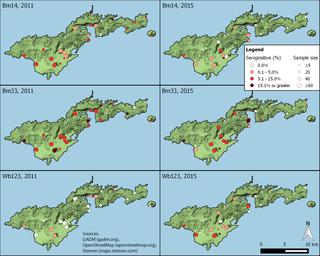PLOS Neglected Tropical Diseases ( IF 3.4 ) Pub Date : 2018-03-09 , DOI: 10.1371/journal.pntd.0006347 Kimberly Y Won 1, 2, 3 , Keri Robinson 1 , Katy L Hamlin 1 , Joseph Tufa 4 , Margaret Seespesara 4 , Ryan E Wiegand 1 , Katherine Gass 5 , Joseph Kubofcik 6 , Thomas B Nutman 6 , Patrick J Lammie 1, 5 , Saipale Fuimaono 4

|
Background
Current WHO recommendations for lymphatic filariasis (LF) surveillance advise programs to implement activities to monitor for new foci of transmission after stopping mass drug administration (MDA). A current need in the global effort to eliminate LF is to standardize diagnostic tools and surveillance activities beyond the recommended transmission assessment survey (TAS).
Methodology
TAS was first conducted in American Samoa in 2011 (TAS 1) and a repeat TAS was carried out in 2015 (TAS 2). Circulating filarial antigen (CFA) and serologic results from both surveys were analyzed to determine whether interruption of LF transmission has been achieved in American Samoa.
Principal findings
A total of 1,134 and 864 children (5–10 years old) were enrolled in TAS 1 and TAS 2, respectively. Two CFA-positive children were identified in TAS 1, and one CFA-positive child was identified in TAS 2. Results of both surveys were below the threshold for which MDA was warranted. Additionally, 1,112 and 836 dried blood spots from TAS 1 and TAS 2, respectively were tested for antibodies to Wb123, Bm14 and Bm33 by luciferase immunoprecipitation system (LIPS) assay and multiplex bead assay. In 2011, overall prevalence of responses to Wb123, Bm14, and Bm33 was 1.0%, 6.8% and 12.0%, respectively. In 2015, overall prevalence of positive Bm14 and Bm33 responses declined significantly to 3.0% (p<0.001) and 7.8% (p = 0.013), respectively.
Conclusions/Significance
Although passing TAS 1 and TAS 2 and an overall decline in the prevalence of antibodies to Bm14 and Bm33 between these surveys suggests decreased exposure and infection among young children, there were persistent responses in some schools. Clustering and persistence of positive antibody responses in schools may be an indication of ongoing transmission. There is a need to better understand the limitations of current antibody tests, but our results suggest that serologic tools can have a role in guiding programmatic decision making.
中文翻译:

美属萨摩亚重复淋巴丝虫病传播评估调查中抗原和抗体反应的比较
背景
目前世卫组织关于淋巴丝虫病 (LF) 监测的建议建议规划实施活动,以在停止大规模药物管理 (MDA) 后监测新的传播病灶。全球消除 LF 的当前需要是将诊断工具和监测活动标准化,超出推荐的传播评估调查 (TAS)。
方法
TAS 于 2011 年首次在美属萨摩亚进行(TAS 1),并于 2015 年进行了重复 TAS(TAS 2)。分析了两次调查的循环丝虫抗原 (CFA) 和血清学结果,以确定是否在美属萨摩亚实现了 LF 传播的中断。
主要发现
共有 1,134 和 864 名儿童(5-10 岁)分别参加了 TAS 1 和 TAS 2。在 TAS 1 中确定了两名 CFA 阳性儿童,在 TAS 2 中确定了一名 CFA 阳性儿童。两项调查的结果均低于 MDA 的阈值。此外,分别通过荧光素酶免疫沉淀系统 (LIPS) 测定和多重微珠测定测试了来自 TAS 1 和 TAS 2 的 1,112 和 836 个干血斑的 Wb123、Bm14 和 Bm33 抗体。2011 年,对 Wb123、Bm14 和 Bm33 反应的总体流行率分别为 1.0%、6.8% 和 12.0%。2015 年,Bm14 和 Bm33 阳性反应的总体流行率分别显着下降至 3.0% (p<0.001) 和 7.8% (p = 0.013)。
结论/意义
尽管通过 TAS 1 和 TAS 2 以及这些调查之间 Bm14 和 Bm33 抗体流行率的总体下降表明幼儿的接触和感染减少,但在一些学校中仍有持续的反应。学校中阳性抗体反应的聚集和持续存在可能表明正在持续传播。有必要更好地了解当前抗体测试的局限性,但我们的结果表明,血清学工具可以在指导计划决策方面发挥作用。











































 京公网安备 11010802027423号
京公网安备 11010802027423号